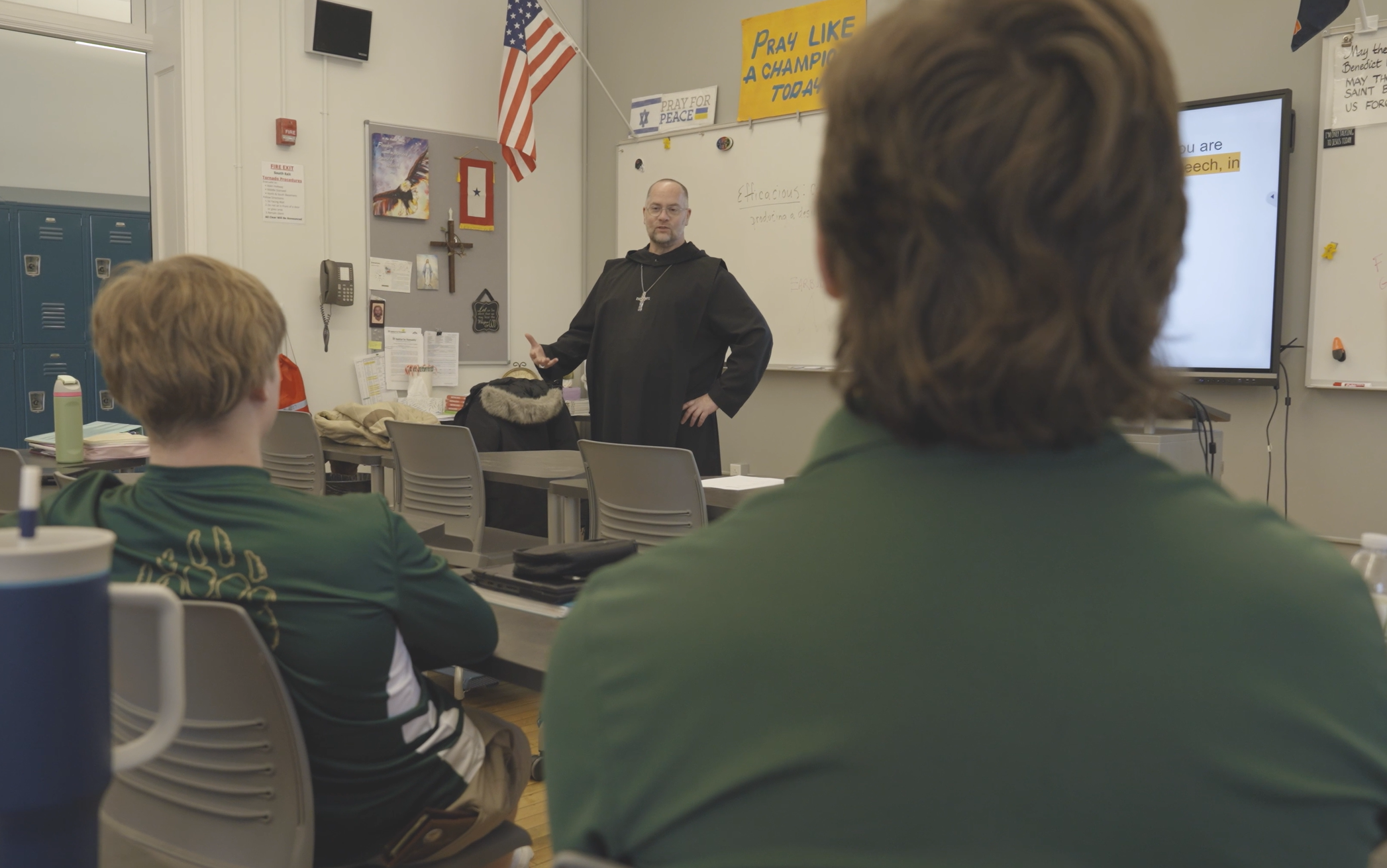Scholarship, education, and the Benedictine monks
Abbot Michael Calhoun, OSB, in the classroom at St. Bede Academy
The Benedictine tradition has a long, rich relationship with scholarship. Over a 1,500-year history, Benedictine monks have been writers, philosophers, intellectuals, and educators. But most importantly, this tradition doesn’t come from a mere love of learning. It is a deliberate theological and spiritual vision, placing education in service of God, community, and the human soul.
For those who want to learn how to become a monk, it’s key to understand the role that scholarship will play. Whether you take on the responsibility of being a teacher, pursue your own intellectual writing, or simply appreciate learning within the Benedictine tradition—education will be a core element in your monastic life.
The Rule of St. Benedict and its influence
The scholarly tradition of the Benedictines can be traced back to its founder, St. Benedict, and his text, The Rule.
Though he did not set out to form a scholarly order, The Rule does encourage learning through its lessons. And those ideas set the stage for further intellectual curiosity and rigor among the Benedictines.
Chapter 48 is centered on the daily practice of manual labor. St. Benedict draws a direct line between physical work and intellectual rigor. He writes that each monk is to be given a book from the monastery’s library that they must read straight through. Additionally, he sets the expectation that monks are literate enough to read and memorize Scripture passages.
Or, consider the Lectio Divina. This slow, meditative daily reading of Scripture fosters contemplation and insight. The routine naturally encourages thoughtfulness among the Benedictines.
You can learn about the Lectio Divina and additional monks’ prayers here.
In fact, the entire monastery is built around stability and order. This creates a natural structure and the necessary time for sustained study. Similarly, silence in the Benedictine monastery provides an inner stillness, conducive to reflection and intellectual depth.
You can learn more about silence and the Benedictines here.
It’s important to note that The Rule doesn't mandate formal study. Instead, it assumes that monks will be engaged readers and thoughtful listeners—particularly to Scripture, the Church Fathers, and spiritual writings.
You can learn more about The Rule here.
Monasteries as centers of learning
In the early medieval period, Benedictine monasticism spread across Europe, establishing the monasteries as cultural centers of influence. The monks became scholars, theologians, and chroniclers of history and their own studies. They began to copy and document ancient manuscripts—both religious writings as well as secular texts from Aristotle, Cicero, and more.
Naturally, Benedictine monks became educators, running schools for novices and oblates. Occasionally, local lay children would learn under the tutelage of Benedictine monks, forming some of the first structured education in early medieval Europe.
Monasteries like Monte Cassino and St. Gall kept vast libraries along with writing rooms known as scriptoria. These libraries included cataloging systems and became intellectual reservoirs, influencing later universities. In fact, many of these 12th and 13th century universities based their foundational curriculum—the trivium and quadrivium—on monastic schooling. One can even see a direct influence between the monastic model (including communal living, spiritual discipline and textual mastery) on early university culture.
Scholarly contributions of the Benedictines
As the Benedictine monks began to take on educational roles and produce writings, their influence became even greater
Notably, St. Bede the Venerable, the namesake of our monastery in Illinois, made key intellectual contributions that spanned beyond just the Benedictine world. The English monk and historian was known for The Ecclesiastical History of the English People, an early model for historical writing and chronicle of English Christian heritage. St. Bede’s biblical commentaries and scientific work also had a wide influence. His study of time and calendars helped determine the date of Easter. And St. Bede’s writings introduced Anno Domini (A.D.) to refer to the years after birth of Jesus.
You can learn more about St. Bede’s story here.
There was also St. Anselm of Canterbury, a philosopher and theologian, credited with formulating the ontological argument that defines God as “that which nothing greater can be conceived.” In the 19th Century, when Pope Leo XIII directed the establishment of a Benedictine residential college, it was natural that St. Anselm would be that school’s patron. Sant’ Anselmo has since formed numerous scholars, philosophers, and leaders in the Church, becoming a hub for theological research and dialogue.
You may notice a theme in these intellectual achievements: the marriage of religion and broader scholarly disciplines. This is not a coincidence. Benedictine education relies on the liberal arts as tools for interpreting and understanding Scripture. Because of that, learning inside the monastery is never pursued for its own sake. Rather it is a means to deepen spiritual insight, better serve the liturgy and bring order to monastic life.
Benedictine education and scholarship today
Today’s Benedictine monasteries—including our monastery in Illinois—still act as educational institutions. Many have an affiliated school or college with Benedictine monks who publish scholarly journals and translations.
A hallmark of this education is the blending of academic rigor with contemplative depth. Just as The Rule encourages monks to seek God in all things, modern Benedictine scholars seek to integrate faith and reason.
So, the Benedictine tradition of scholarship isn’t just a bonus. It’s integral to the monastic way of life: rooted in monks’ prayer, guided by humility, and sustained by community. Benedictine learning is less about intellectual achievement than it is about wisdom, discernment, and the transformative power of truth.
As you continue to ask the question “how do I become a monk,” you’ll learn more about the elements that shape the Benedictine order, like scholarship and education. And if these qualities speak to you, consider reaching out to discuss the next steps in your spiritual journey at our monastery in Illinois by submitting a form at this link.

